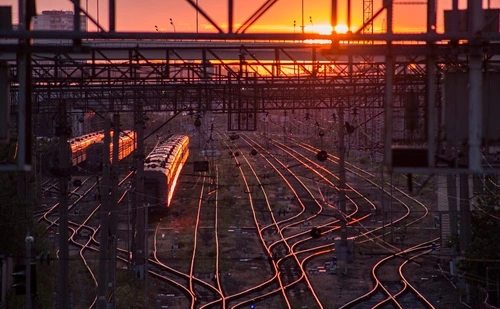Whether it is for the transportation of goods or raw materials or people using it for commuting purposes, railways are one of the best transportation out there, right? You might have heard people say that European countries have the best railway networks or railway experience in the world, but is that the case though? Well, come with us as we go on a little detour to take a good look at the 10 countries with the largest railway network in the world as of 2024. And believe us when we say that “this list can literally surprise you,” because you wouldn’t even believe which countries have made it to this list. Alright, here we go.
1. United States
The United States has the world’s largest network of railways on the planet, which runs to about 220,044 km in total. This vast system is a lifeline to the shipping of goods amidst America’s broad landscapes. It consists of both private and public railways, with most infrastructure being owned by private organizations. The big players, termed Class I railroads, handle over 90% of the freight traffic. While passenger services like Amtrak are crucial, especially in the Northeast Corridor, it’s the freight trains that rule the tracks. Interestingly though, only around 2,025 kilometers are electrified, showing a heavy reliance on diesel-powered locomotives, unlike other countries where a huge part of railways is powered by electricity and not fossil fuel.
2. China
China comes in second with a railway network that spans about 159,000 kilometers. The Chinese railway system has expanded very fast with the use of advanced technologies, especially in the high-speed field, so that over half of its tracks have been electrified, amounting to about 100,000 kilometers. Yearly, over 10,000 kilometers of tracks are put into service in China, and its railway installations connect different provinces with each other via passenger transportation and provide great support for freight transportation, and that’s a huge achievement compared to literally any other country on this list.
3. Russia
Russia’s network of railways is the longest in Europe and the third-largest in the world, at approximately 105,000 km in total length. It unites huge territories spanning from Moscow to Vladivostok. Only 9,000 km of the legendary Trans-Siberian Railway remain. Some 54,054 km are electrified lines that help to provide the effective transport of passengers and cargo between the regions. And as you may know, Russia’s railway experience is super famous in the entire world.
4. India
The Indian railway network is ranked fourth in the whole world with network coverage of about 104,647 kilometers, of which 60,451 km is electrified and actively utilized. Owned by the state, Indian Railways is there for not only the passengers but for the transportation of the things or material through the country. The network carries over 23 million passengers per day and, hence, is the most traveled passenger rail network all over the world. It links the rural and the urban, booms up trade, and increases economic progress, furthermore, it provides affordable travel to the public.
5. Canada
Canada has the fifth-largest rail network in the world, with about 49,422 km of route. Primarily used for freight, the network is dominated by Canadian National (CN) and Canadian Pacific (CP). Train service is provided to passengers by Via Rail, which connects important cities and regions from Montreal to Toronto and Vancouver, whose routes cover only a small portion of the country. Beyond their utility, the railway network also holds scenic routes, with one of the best examples being the Rocky Mountaineer, which carries passengers across the Canadian Rockies in luxury.
6. Germany
Germany’s railway network totals some 40,625 km in length and is the sixth largest network in the world. Known for its high efficiency and extensive electrification, with roughly 22,500 kilometers of electrified tracks, Germany’s rail system is both vast and modern. In cities such as Berlin, Munich, and Hamburg, the S-Bahn and U-Bahn systems provide effective transit within each city. This is an excellent way in which residents and tourists can easily travel to the vast areas of each city.
7. Argentina
Argentina’s railway system is the 7th largest in the world and extends to 36,966 km. There is freight and passenger transportation through this network, though a noticeably large proportion is utilized just for the transportation of agricultural products, minerals, and other cargo. The Argentine railways are public and private, and they are important in moving commercial products from a far distance to be transferred locally toward the export ports of the country. Buenos Aires also has a well-developed suburban rail system highly important for daily commutes and tends to relieve urban road traffic pressure.
8. Australia
Australia has an approximately 33,168 km railway network, which gives it the eighth position globally. Although freight is the main purpose for which the network is in place, it also provides relatively large-scale passenger services within cities. These urban rail networks in cities like Sydney and Melbourne serve to be an effective means in the facilitation of commuting and also ease congestion on the roads.
9. Brazil
Brazil’s railway network is the eighth-largest in the world, with an estimated 29,817 km of total length. The country makes intensive use of its railway network for the transportation of iron ore, soybeans, and sugar for export. The railways of Brazil connect agricultural and mining regions to the interior of Atlantic ports for international trade and economic development. It also provides passenger services, specifically in the major urban centers, such as São Paulo and Rio de Janeiro, where there are large urban rail networks that have helped reduce traffic congestion.
10. France
France’s 29,273 km railway network is the 10th biggest or longest in the world, known for its high-speed services such as the TGV (Train à Grande Vitesse), which allows interconnection between the main cities of France and some others of its neighboring countries. Approximately 15,687 km are electrified to allow for the efficient operation of high-speed and regular lines.
Conclusion
That’s all there is for now. Since a railway network isn’t being built pretty often like a road, that’s why you won’t see much of a change in the ranking of this list. But anyway, if there is something, we’ll keep you posted with the latest data as well as facts.

Brandon is the cheif editor and writer at WorldUnfolds.com. With a passion for storytelling and a keen editorial eye, he crafts engaging content that captivates and enlightens readers worldwide.















